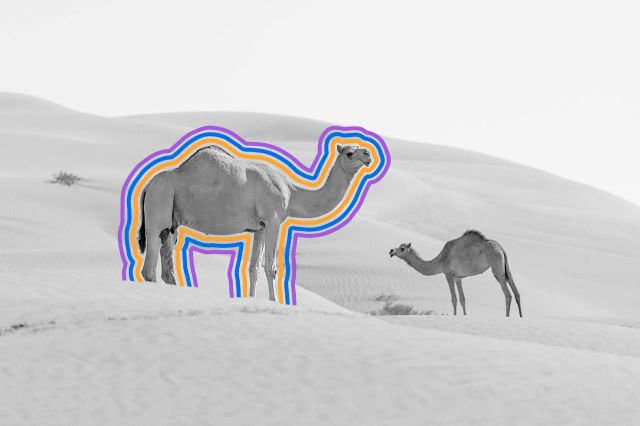
There Are Only Three Camel Species
Only three species of the Camelus genus are still living today. The first two — the dromedary or Arabian camel (Camelus dromedarius) and the Bactrian or Mongolian camel (Camelus bactrianus) — are both domesticated species. The most obvious difference between the two is that a dromedary has only one hump, while a Bactrian camel has two. The dromedary camel has existed in the wild for more than 2,000 years, and was, like its alternative name suggests, first domesticated in the Arabian Peninsula. The Bactrian camel, named for the Persian province of Bactria around modern Afghanistan, Uzbekistan, and Tajikistan, was a popular pack animal in Asia and filled caravans along the ancient Silk Road.
The third camel, known simply as the wild Bactrian camel (Camelus ferus), is visually akin to its domesticated cousin. In fact, it was once believed that the wild camel was simply a feral version of its similarly named relative, but genetics confirmed that the two camels separated some 1.1 million years ago. With a population of less than 1,000, the wild Bactrian camel is the eighth-most critically endangered mammal on the planet. Today, it’s mostly found in the remote parts of the Gobi desert in Mongolia and China.

A Camel’s Hump Stores Fat — Not Water
A persistent camelid myth is that these “ships of the desert” store water in their hump(s). Instead of H20, camels actually store fatty tissue that can be drawn upon when food is scarce — a common occurrence when traipsing the desert. Because they store fat vertically in their humps (and not throughout their body), camels can also dissipate excess heat more quickly. These strange humps may not be the most elegant thermoregulating solution Mother Nature has ever devised, but it certainly works for them.

North America Used to Have Its Own Native Camels
Some 11,700 years ago, the last native North American camelid species, in a genus known as Camelops, went extinct — a strange end for a species that originally evolved on the continent 44 million years ago during the Eocene period. The creature stood approximately 7 feet tall, weighed around 1,800 pounds, and looked remarkably similar to today’s dromedary, though experts are not 100% certain whether Camelops had a hump like its Arabian cousin. The Camelops died out around the same time as other large mammals in North America, such as mastodon and giant beavers, likely due to increased human hunting.
Camels (imported from the Mediterranean and the Middle East) did make a small comeback in the U.S. during the mid-19th century, when the U.S. government thought they would be the perfect beasts of burden for delivering supplies to military outposts in the Southwest. The Army’s short-lived Camel Corps was soon disbanded due to the Civil War and other factors, however, and the herds were sold off or let loose, with many roaming wild for years. Feral camels were spotted in the deserts of the Southwest up until the early 20th century.
More Interesting Reads

A Camel Can Drink 30 Gallons of Water in 13 Minutes
If a dromedary or Bactrian camel comes upon a chance oasis or watering hole, it’s game time. Camels don’t lap water like most mammals, but instead suck down water almost like a vacuum, drinking as many as 30 gallons of water in 13 minutes. Such a deluge of water would be fatal for humans (and most other mammals) because the increased amount of fluid would dilute our blood and cause our cells to explode, but camels don’t have this problem because they can essentially store water in their first stomach, or rumen. This stomach allows the water to be released to the blood over the course of several hours. Camels also have superpowered blood cells capable of expanding to twice their size. As a camel uses up water and fatty tissue, its hump(s) will actually begin to deflate, but give a camel some food and a lot to drink, and it’ll spring back as good as new.

Camels Are Nearly as Fast as Racehorses
They may not look it, but camelids are extremely agile, and can reach speeds of 40 miles per hour at a dead sprint. At endurance speeds, camels can maintain a speed of roughly 25 mph for an hour, or 12 mph for eight hours. This doesn’t quite match a horse in terms of sheer sprinting speed, but things change when the race moves to a camel’s home turf. A camel’s feet are much larger than a horse’s hooves, and that extra surface area helps camels stay on top of sand for easier transportation.
Because camels are so impressively fast — the Greek root word within “dromedary” means “running,” after all — camel racing is a popular sport in many parts of the world, and has been for millennia, especially in the Arabian Peninsula. Camel racing became more formalized in the late 20th century, and is now a major sport drawing participants from around the globe.

Camels Are Perfectly Built for the Desert
Camels, both Bactrian and dromedary, are purpose-built for the desert. Yes, their fat-storing humps, impressive thermoregulation, oval-shaped blood vessels, and wide feet all aid these incredible creatures as they traverse some of the world’s most arid landscapes — but that’s really only the beginning of a camel’s fine-tuned, desert-ready biology.
For example, camels have three sets of eyelids, and two sets of eyelashes for batting away sand and dirt. Although it may seem counterintuitive, a camel’s furry coat keeps it from sweating, insulates it from the heat, and also keeps it warm when the temperature drops (it can get deathly cold when the sun sets in the desert). Also, because the sand can sometimes be scorching, camels have leather-like, heat-resistant pads on their knees, elbows, feet, and sternum, so they can lay down without getting burned. They even lack a certain skin fold found in other animals so that air can continue circulating under their bodies when lying down. Even their lips and tongues are extra hardened so they can eat prickly desert plants that other animals have to give a hard pass. Thanks to millions of years of evolution, the camel is truly one of the desert’s greatest masterpieces.











